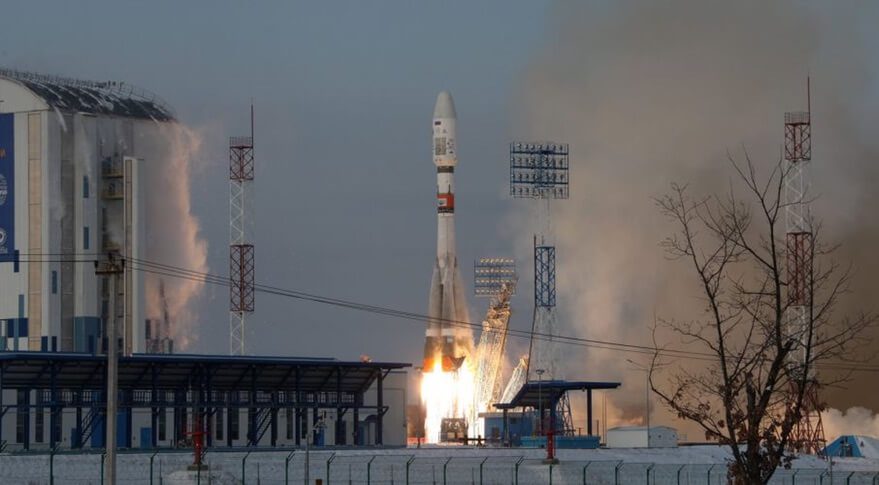A Soyuz 2-1B Fregat launched from the new Vostochny site in Far Eastern Russia, at 0541 GMT on 28 November, ended in total failure when its fourth stage, the Fregat upper stage, was apparently sent in the wrong direction during its first firing. Interfax reports that a software mistake uploaded to the Fregat’s flight computer caused the upper stage to be in an incorrect orientation for the main engine’s first 77s burn. As a result, the Fregat upper stage, with its 19 satellite payloads, did not achieve the parking orbit and fell back with parts surviving the re-entry falling into the Atlantic Ocean.
Update on 1 December: An full investigation into the failure is underway. A preliminary conclusion is that as the Fregat’s control system attempted to make a small two degree rotational orientation change, due to a software error, the guidance system adjusted it from the other direction, making a 358 degree rotation instead. The problem was that the Fregat stage was in the middle of this change when its orbit raising firing took place, sending Fregat and its payloads in the wrong direction resulting in a failure to achieve orbital velocity.

Soyuz 2-1b launch from Vostochny took off successfully but went wrong later. Courtesy: Roscosmos
After achieving the planned parking orbit, the original flight plan was for the Fregat to make a further series of engine burns in order to drop off its “passenger” satellites in their various orbital locations. The main payload “passenger” carried on the failed flight was the 2.7 metric ton Meteor M2-1 weather satellite. This satellite was insured for the rouble equivalent of US$44.3 million on both the Russian and International Insurance Markets and a pay out for total loss is now expected.
Among the major secondary payloads carried were: the 100kg Baumanets 2 – a remote sensing satellite for the Bauman State Technical Institute in Moscow; the 70kg Telesat LEO-2 Vantage test satellite, which was to act Ka-band communications technology test and frequency placeholder for a planned 100-satellite constellation for Telesat; and the IDEA-OSG 1, a 22kg spacecraft on an Orbital Debris Monitoring mission being flown for Astroscale Japan.
None of these satellites was insured except for the Space Systems/Loral built Telesat LEO-2 Vantage test satellite which was insured in conjunction with its stablemate the Telesat LEO 1 which is flying on a PSLV launch later this year. There will be no insurance payout at this point as there was a one launch/satellite deductible. The Telesat LEO 1 satellite, this time by SSTL, now has to fly successfully in order to hold Telesat’s frequency allocation from the International Telecommunications Union.
The secondary “cubesat class” payloads included 10 Lemur 2 ship-tracking and atmospheric research satellites being carried for Spire Inc; two Corvus-BC remote sensing satellites (3 and 4) for Astro Digital; the SEAM spacecraft set to provide high resolution measurements of magnetic and electrical fields in the Ionosphere for KTN Royal Institute of Technology in Sweden; D-Star 1 – a communications constellation satellite demonstator for German Orbital Systems; and, finally, the AIS-SAT 3 ship-tracking Automatic Identification System (AIS) satellite for Norway.
Comment by David Todd: Soyuz used to be the byword for launch reliability. However, suspect quality control continues to hold back what should be a very reliable rocket design. Apart from this month’s launch failure, it became apparent that there was something wrong on the Soyuz 2-1A/Fregat M launch in July, which involved a similar Fregat multi-drop flight plan. This resulted in 12 satellites (including two Corvus-BC satellites) either not being delivered correctly into the right orbit or failing soon after one of the “delivery” stops. Despite official denials by Russian authorities, Seradata regards this July flight as a “raw” launch failure and as an “adjusted” partial failure, given that at least one satellite did not achieve an operational condition or was not delivered into the right location due to the launch vehicle.
In addition to the above, the predecessor type to the Soyuz 2 launch vehicle series, the Soyuz-U, suffered a third stage engine failure in December last year which lost the Progress MS-04/ISS-65P freighter spacecraft it was carryng to the International Space Station (ISS).






